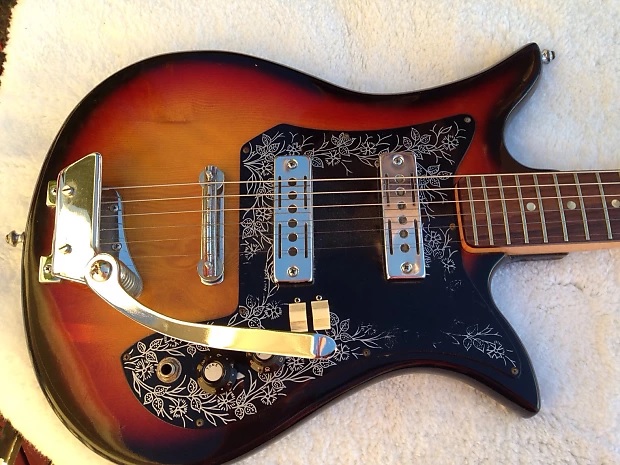

The trussrod extends beyond the heel of the neck (like a MusicMan or Sadowsky), so adjustments are a breeze.
#TEISCO GUITAR IDENTIFICATION PLUS#
22 frets are sunk into the board, plus a bonus zero fret, which I do not see terribly often.

The 25.5-inch scale neck is multi-ply maple with a rosewood fretboard and some sort of darker wood overlay on the Strat-style feedstock. The original pickguard is to die for, with a cool vines and flowers engraving on it. Strings are loaded through a unique stamped steel tailpiece, and there should be some sort of pot metal bridge, but it has been replaced by a chunk of wood. The body is loaded up with one single coil pickup that is wired through volume and tone knobs that are original and still have the little pointers. I have no idea what it is made of, but it is very thin, maybe 2/3 the thickness of a Telecaster, so it weighs in at a feather-light 5 pounds, 9 ounces.

It has a tulip-shaped body that is sprayed in a cool shade of red.
#TEISCO GUITAR IDENTIFICATION SERIAL NUMBER#
This one is an E-110, though it took a little searching on the internet to find it as the sicker on the back of the body with the serial number and model number is missing (as is the ubiquitous “Steel Reinforced Neck” sticker). By the way Teisco Del Rey was the name found on guitars imported to the US by Chicago’s Jack Westheimer from 1965 to 1969. But everybody and their brother want s a Teisco Del Rey. These guitars were often sold at department stores (such as Sears), and were also imported under other names including: Arbiter, Audition, Beltone, Duke, Heit Deluxe, Jedson, Kay, Kent, Kimberly, Kingston, Lyle, Norma, Silvertone, Sonatone, Top Twenty, Tulio and World Teisco. So most of the Teisco badged guitars you see were built between 19, or 19 for Japanese market instruments. The company was the brainchild of a guitarist, Atswo Kaneko, and it went through various company names before Teisco was chosen in 1964. The company was sold to Kawai in 1967, and they discontinued selling guitars under the Teisco brand name in 1969 (for export) and 1977 (for Japan). They sold instruments domestically and also distributed gobs of them to the United States and Great Britain. They built amplifiers and keyboards and distributed drum sets (made by others), but I am most interested in guitars and basses, so this is what you get. Teisco was a Japanese company that built guitars from 1948 to 1969, and Teisco is an acronym for Tokyo Electric Instrument and Sound Company. Today we are looking at a little bit of Japanese guitar history: a Teisco Del Rey E-110 6-string electric guitar that I picked up at the Rose Bowl Flea Market last month.


 0 kommentar(er)
0 kommentar(er)
